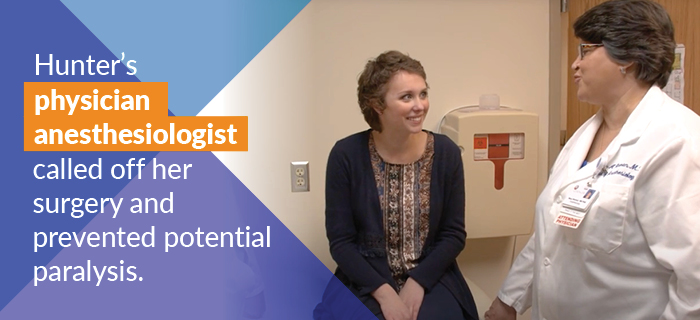What is a physician anesthesiologist?
Physician anesthesiologists are medical doctors just like your primary care physician and surgeon. They specialize in anesthesia care, pain management, and critical care medicine, and have the necessary knowledge to understand and treat the entire human body. Physician anesthesiologists have 12 to 14 years of education, including medical school, and 12,000 to 16,000 hours of clinical training.
Physician anesthesiologists evaluate, monitor, and supervise patient care before, during, and after surgery, delivering anesthesia, leading the Anesthesia Care Team, and ensuring optimal patient safety.
Physician anesthesiologists specialize in anesthesia care, pain management, and critical care medicine.
What types of anesthesia do physician anesthesiologists provide?
Physician anesthesiologists are usually in charge of providing the following types of anesthesia care:
How does the physician anesthesiologist care for you during surgery?
Physician anesthesiologists guide you throughout your entire surgical experience:

How are physician anesthesiologists involved in treating chronic pain?
Physician anesthesiologists specialize in pain control, and some focus their practices on treating patients with chronic pain. If you suffer from pain that won’t go away, such as migraine headaches, back pain, or pain caused by a condition such as fibromyalgia, ask your doctor about a referral to a physician anesthesiologist who specializes in treating chronic pain.
**What is a Physician Anesthesiologist?**
**Introduction:**
A physician anesthesiologist, commonly known as an anesthesiologist, is a highly skilled medical professional specialized in providing anesthesia during surgeries, medical procedures, and diagnostic tests. They play a vital role in ensuring patient safety, comfort, and well-being during these critical events.
**Roles and Responsibilities:**
* **Anesthesia Administration:** Anesthesiologists administer various types of anesthesia, including general, regional, and local anesthesia, to block pain and ensure patient relaxation during medical interventions.
* **Patient Monitoring:** They continuously monitor the patient’s vital signs, such as heart rate, respiration, and blood pressure, to ensure optimal patient safety and prevent complications.
* **Medication Management:** Anesthesiologists manage medications used during anesthesia to control pain, prevent nausea, and support respiratory function.
* **Emergency Management:** They are trained to handle emergencies during anesthesia and can provide life-saving interventions as needed.
* **Patient Education:** Anesthesiologists educate patients and their families about anesthesia, its risks, and the recovery process.
**Education and Training:**
Becoming a physician anesthesiologist requires extensive education and training:
* **Medical School:** Graduates with a medical degree (M.D. or D.O.).
* **Residency Program:** Completes a four-year residency program in anesthesiology, which includes hands-on clinical experience.
* **Board Certification:** Graduates are board-certified in anesthesiology by the American Board of Anesthesiology (ABA).
**Scope of Practice:**
Anesthesiologists work in various healthcare settings, including:
* Hospitals
* Surgery centers
* Pain management clinics
* Dental offices
They collaborate closely with surgeons, other physicians, nurses, and healthcare professionals to provide comprehensive patient care.
**Keywords:**
* Physician Anesthesiologist
* Anesthesiologist
* Anesthesia
* Surgery
* Patient Safety
* Patient Monitoring
* Emergency Management
* Medical School
* Residency Program
* Board Certification
* Healthcare Settings





What does an anesthesiologist do
The title of your question is “What is a physician anesthesiologist